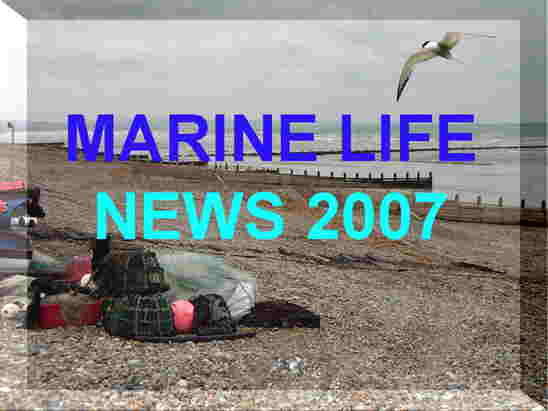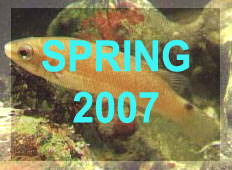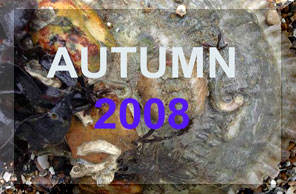EVENTS:
11-15
November 2008
World Conference
on Marine Biodiversity
Valencia,
Spain
The
exploration of marine biodiversity: scientific and technological challenges
To
review the current understanding of marine biodiversity, its role in marine
ecosystem functioning and its socio-economic context
To
assess current and future threats and potential mitigation strategies for
conservation and regulation of marine resources
To
identify future research priorities
First
Announcement (Link)
Full
Details (Link)
LATEST
NEWS:
29
June 2008
Another
huge Edible Crab,
Cancer
pagurus, was discovered and brought
ashore by Paul Worsley
diving in Lyme Bay,
Dorset. It was estimated to be 300 mm wide across the carapace and a crab
of this size would be the largest on record. (The
largest recorded specimen known was 285 mm wide.) Its huge size can be
verified by the photograph in the Western
Morning News but unfortunately the crab was eaten before a tape measure
could put on the shell and photographed to verify the crab as the largest
on record.
26
June 2008
A
huge Edible Crab,
Cancer
pagurus, was captured and brought
to the surface from a plastic barrel on the seafloor at Balaclava
Bay off Portland, Dorset. The male crab was not measured but estimated
to be about 30 cm wide across the carapace. It was found a home in Weymouth
Sea Life Centre. Both its massive claws were intact and bigger than
my hands.
Capture
and Report by Paul Martin
with
the help of companion diver Mary Harris
Dorset
Echo Report
BMLSS
Edible Crab
22
June 2008
An
injured Risso’s
Dolphin, Grampus griseus, was discovered
swimming in the River
Clyde, Glasgow, Scotland, and it is not expected to survive. This
is a deep water species.
17
June 2008
I
found a dead White-beaked Dolphin,
Lagenorhyncus
albirostris, on Baleshare
Beach, on the west coast of North
Uist in the Outer Hebrides in the morning under a bright blue sky.
It was 2.10 metres long.
Whales
& Dolphins in British Seas (Link)
June
2008
A
rare female Marbled Electric Ray, Torpedo
marmorata, was captured in a trawl
net by Worthing fisherman Brian Davey about
eight miles off Shoreham-by-Sea, Sussex.The
ray which was about 60 cm long and can deliver a 220 volt electric shock.
It was kept alive found a home at Brighton
Sea Life Centre.
Shoreham
Herald News Report
This
is the rarer of the two electric rays recorded in British seas and is extremely
rare off Sussex. This fish can grow up to 60 cm in length. It is not known
to breed in British seas and fish are likely to have migrated up the English
Channel in summer.
BMLSS
Sharks & Rays
BMLSS
Marbled Electric Ray
Sussex
Rare Fishes
Sussex
Marine Life Reports 2008
Adur
Nature Reports 2008
BMLSS
Shark & Ray News
14
June 2008

Venue:
Coronation
Green, Shoreham-by-Sea
Admission:
FREE
Adur was
one of the UK leaders in presenting an environmental exhibition of World
Oceans Day on Coronation
Green, Shoreham-by-Sea,
as part of the Adur
Festival.
9
June 2008
At
least 26 Common Dolphins, Delphinus
delphis, died after becoming stranded
in Porth
Creek up the Percuil
River, Cornwall. (The Percuil River meets
the Carrick
Roads sea inlet near Falmouth.) These
were just a small group of many more dolphins
in the Carrick Roads around Falmouth.
Whales
& Dolphins in British Seas (Link)
BMLSS
Cetacea
5 June
2008
In
the early hours a large Stingray,
Dasyatis
pastinaca, was caught by an angler Ken
Canning off the beach at Pagham
Harbour, Sussex, and released back alive. It weighed between 65 lb
and 72 lb; this should be a BR
(R-C) FC record.
“This
magnificent fish which was probably around 72 lb as that’s what
it weighed first time but it slipped of the sheet. When weighed second
time it was still touching the floor but we were concerned with the health
of the fish so settled on 65 lb 2 oz then returned it.”
British
Shore Caught Angling Records
BMLSS
Shark & Ray News
3 March
- 26 May 2008 onwards
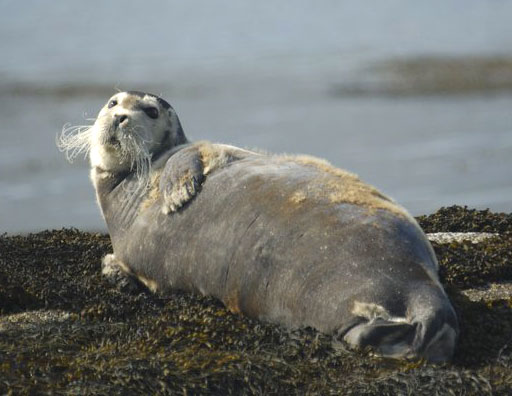
A
Bearded
Seal, Erignathus
barbatus, was spotted at Loch
na Keal on the Isle of Mull,
a large island
in the Inner Hebrides, western Scotland. The healthy seal
had hauled itself up on to some dry rocks when it was first seen. Subsequently,
it has been unpredictable in its movements.
The
Bearded
Seal was first seen by David
Woodhouse (Mull Wildlife Expeditions)
on
3
March 2008.
BMLSS
Bearded Seals
Andy's
Mull Blog
May
2008
A
surprising capture of a Pacific Humpback
Salmon,Oncorhynchus gorbuscha, specimen
caught by Louis Hunter
in the River
Tweed near Berwick-upon-Tweed
on the English-Scottish border, is the first to be caught in a British
river by rod and line, weighed, verified, and submitted to the British
Records Fish Committee (BRFC). The committee has recorded it as a new
species on its game list. The fish weighed 1.6 kg.
Its
origins are likely to be the Barents
Sea, where the Russians introduced thousands of Humpback
Salmon 40 years ago as part of a large breeding
programme.
Over
the last 10 years some of these have successfully bred in rivers in Norway
and Iceland. It appears they have begun to cross the North Sea to Britain,
although there is no evidence yet to suggest they are breeding here. There
has been anecdotal evidence of fishermen accidentally snaring them in trawler
nets off the east coast.
11
May 2008
A
female Deep-water Red Crab,
Chaceon
(=Geryon)
affinis,
was
captured in deep water (300 metres) off the west off the Orkney
Isles, north of Scotland. It survived a number of days in a boats vivier
tank before being transferred to an aquarium.
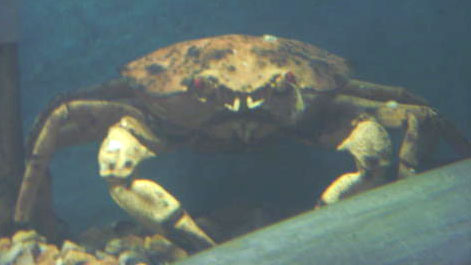
The
Orkney fishermen call them "Red Crab"
but they are not common.
ID
by Richard Lord (Guernsey)
Sealord
Photography
This
geryonid crab Chaceon affinis
has been widely reported from both the North & South Atlantic as well
as the Indian Ocean in depths ranging from 410 to 2047 metres. In the NE
Atlantic, it has been recorded from N & SW Iceland, W Norway, SW Rockall,
Ymir Ridge, Wyville-Thompson
Ridge, W of St Kilda & WNW
Butt of Lewis (Scotland), and NW Skellig
Islands (Ireland) at 160-193 metres. Significant quantities have been
taken by deep-water crab potters off the west coast of Ireland.
Ref: Quigley,
D.T.G., Flannery, K. & Holmes, J.M.C. (1994) First record of the crab
Chaceon
(=Geryon)
affinis from Irish waters.
The
Irish Naturalists' Journal 24(11): 460-461.
More
Information & Photographs
8 -9
May 2008
Guernsey
recreational fisherman Andy Marquis
discovered the pulmonate slug Celtic Sea
Slug, Onchidella
celtica, at St.
Martins Point, Guernsey. (I have been
looking for them for a decade without success!)
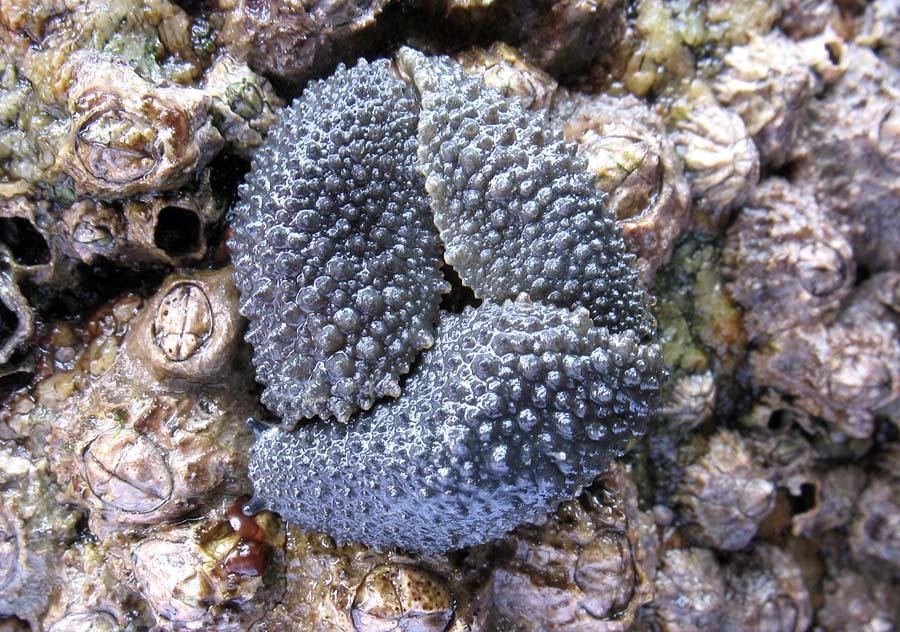
The
following day my wife and I found 278 individuals in the Fucus
spiralis zone on the vertical face of
a rocky outcrop. I submitted the record to
Dr.
Charles David of La
Société Guernesiaise and the Guernsey
Biological Records Centre and he provided further information of their
occurrence in the Bailiwick of Guernsey: Moulin Huet Bay (south coast),
the Gouliot
Caves (Sark),
and Burhou and the Chausey
Islands. The ones I have seen have been much blacker.
Sealord
Photography
Early
May 2008
A
Thresher
Shark,
Alopias
vulpinus, was
seen feeding at the surface off Portland,
Dorset, exceptionally early in the year.
Report
by Paul Martin
BMLSS
Sharks
BMLSS
Shark & Ray News
6 May
2008
A
400 metre (1,312 ft) section of land slipped onto the beach between Lyme
Regis
and Charmouth. Local
Police described the landslip as the "worst for 100 years.
BMLSS
Lyme Regis Notes & Links
24
April 2008
A
Short-snouted
Seahorse*,
Hippocampus
hippocampus, was discovered on the
filtration plant at Shoreham Harbour. It was
alive when found but died shortly afterwards. (*assumed
to be this species).

Seahorses
are now a regular occurrence about two miles offshore.
Report
by Peter Talbot-Elsden
BMLSS
Seahorses
Sussex
Marine Life Reports
11
April 2008
A
most extraordinary angling capture of the Korean
Rockfish, Sebastes
schlegelii, occurred from the charter
vessel "Desire" at Oosterschelde
near Goese Sas, in a coastal inlet in the Netherlands.
Menno
Soes quotes Yoshiaki
Kai (who wrote some papers on Sebastes)
who is willing to be referenced as having identified it as Sebastes
schlegelii. According to him schlegelii is the only species
with three lachrymal spines.
This
is fish is native to the eastern Pacific Ocean but is transferred around
the world in the aquarium and aquaculture industry.
April
2008
A Conger
Eel, Conger
conger, was caught in a beam
trawl off Brixham, Devon, was photographed at the Brixham
Fish Market after it had been gutted prior to auction and it still
weighed 60 kg (134 lb 2 oz).
Conger
Eel Records
3 April
2008
On
a Orca Sea Safaris
two hour marine wildlife safari out into Falmouth
Bay and beyond, we saw three pods of Common
Dolphins, Delphinus delphis,
the first was 7.5 miles ESE from St Anthony Head
where 10-12 Common Dolphins
were exhibiting feeding behaviour. About 1.5 miles further out, a pod of
50 Common Dolphins
were spotted moving at around 14-15 knots, a number of dolphins broke from
the pod to join our boat for a bit of fun and bow riding. Three miles further
west of here we found another 10 Common Dolphins
which approached us and started milling around the boat.
Full
Report
BMLSS
Whales & Dolphins (by Steve Savage)
British
Marine Life News 2007

Cornish
Marine Life 2007 (Ray Dennis Records)
BMLSS
Oil Disasters page



